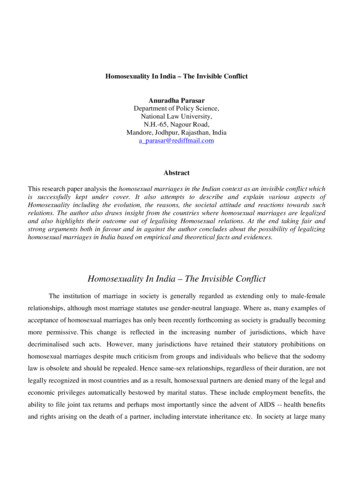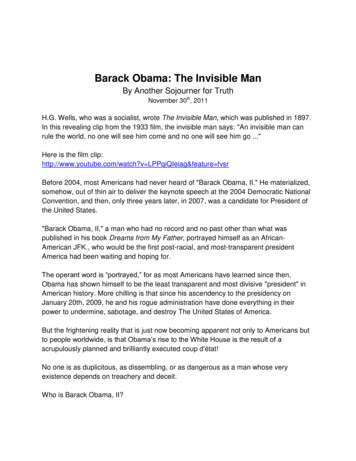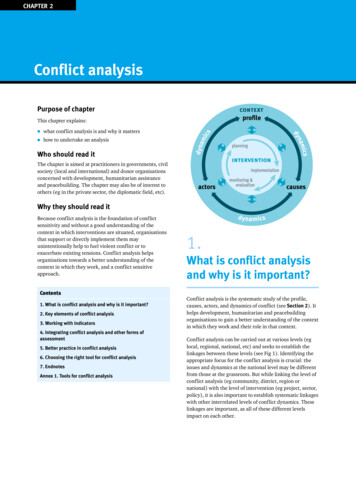
Transcription
Homosexuality In India – The Invisible ConflictAnuradha ParasarDepartment of Policy Science,National Law University,N.H.-65, Nagour Road,Mandore, Jodhpur, Rajasthan, Indiaa parasar@rediffmail.comAbstractThis research paper analysis the homosexual marriages in the Indian context as an invisible conflict whichis successfully kept under cover. It also attempts to describe and explain various aspects ofHomosexuality including the evolution, the reasons, the societal attitude and reactions towards suchrelations. The author also draws insight from the countries where homosexual marriages are legalizedand also highlights their outcome out of legalising Homosexual relations. At the end taking fair andstrong arguments both in favour and in against the author concludes about the possibility of legalizinghomosexual marriages in India based on empirical and theoretical facts and evidences.Homosexuality In India – The Invisible ConflictThe institution of marriage in society is generally regarded as extending only to male-femalerelationships, although most marriage statutes use gender-neutral language. Where as, many examples ofacceptance of homosexual marriages has only been recently forthcoming as society is gradually becomingmore permissive. This change is reflected in the increasing number of jurisdictions, which havedecriminalised such acts. However, many jurisdictions have retained their statutory prohibitions onhomosexual marriages despite much criticism from groups and individuals who believe that the sodomylaw is obsolete and should be repealed. Hence same-sex relationships, regardless of their duration, are notlegally recognized in most countries and as a result, homosexual partners are denied many of the legal andeconomic privileges automatically bestowed by marital status. These include employment benefits, theability to file joint tax returns and perhaps most importantly since the advent of AIDS -- health benefitsand rights arising on the death of a partner, including interstate inheritance etc. In society at large many
of these benefits are available to heterosexual de facto partners, but continue to be unavailable tohomosexual partners.1DefinitionThe word homosexuals literally means as ‘of the same sex, being a hybrid of the Greek prefix homomeaning ‘same’ and Latin root meaning ‘sex’.2 Homosexuality is a sexual orientation characterized bysexual attraction or romantic love exclusively for people who are identified as being of the same sex.People who are homosexual, particularly males are known as ‘gay’, gay females are known as ‘lesbians’.That is homosexual marriages, sometimes referred to as gay marriage, indicates a marriage between twopersons of the same sex.3HistoryThe earliest western document concerning homosexual relationship come from Ancient Greece, wheresame sex relationship were the societal norm. Even homosexual marriages have occurred with relativefrequency in the past, both within Christian and non-Christian communities.4 Researches suggest thatthe Catholic Church, which has been extremely vociferous in its opposition to homosexuality in general,approved of same-sex marriages for over 1 500 years, only ceasing to perform them in the nineteenthcentury.5In preindustrial societies also homosexuality was generally accepted by the lower classes while somemembers of upper classes considered it immoral. However with the rise of urbanization and the nuclearfamily, homosexuality became much less tolerated and even outlawed in some cases. The sexualorientation in pre modern era as depicted in love poetry and paintings and even in historic figures such asAlexander the great, Plato, Hadrian, Virgil, Leonardo da Vinci, Michelangelo and Christopher Marloweincluded or were centered upon relationship with people of their own gender.61A relationship not based on blood or marriage is not entitled for Social Security benefits under Employee Provident FundAct, Pension Act, Workmen Compensation Act, Insurance Act, Housing Act etc.2Older words for homosexuality, such as homophilia and inversion have fallen into disuse. Less frequently used terms arequeer, homo, fag or faggot and dyke.3Homosexual marriages are also known as gender-neutral marriage, equal marriage, and gay les.com/p/articles/mi m2065/is n1 v50/ai 20344099/pg 4 - 28k s/news337.txtg4
However the term homosexuality appears in print for the first time in 1869 in an anonymous Germanpamphlet paragraph 142 of the Prussian penal Code and Its maintenance paragraph 152 of the Draft of aPenal Code for North German Confederation written by Karl Maria Kertbeny. This pamphlet advocatedthe repeal of Prussia’s sodomy laws.7Thus homosexuality is not a new phenomenon. Even instances of homosexuality are available in HinduMythology.8 The literature drawn from Hindu, Buddhist, Muslim, and modern fiction also testifies thepresence of same-sex love in various forms. Ancient texts such as the Manu Smriti, Arthashastra,Kamasutra, Upanishads and Puranas refer to homosexuality.9 Also there are reports that same-sexactivities are common among sannyasins, who cannot marry. Thus instances of homosexuality areavailable in historical and mythological texts world over and India is not an exception to this.The Cultural residues of homosexuality can be seen even today in a small village Angaar in Gujarat whereamongst the Kutchi community a ritualistic transgender marriage is performed during the time of Holifestival. This wedding which is being celebrated every year, for the past 150 years is unusual becauseIshaak, the bridegroom and Ishakali the bride are both men.10Thus the history is filled with evidences proving the existence of homosexuality in past. Whereas in thepast 10 years world over, for the lesbian and gay rights, we find that the legal initiatives have shifted fromthe right to be privately sexual, that is the right to have same-sex relationships at all, to the right to beindividual civic subjects, protected from discrimination in the work place and in the provision of services,toward the right to have relationships given status by the law. This shift in rights-focus, fromdecriminalization, to civil protection, to civil recognition is, not entirely a linear one. Thus in recent yearsa number of jurisdictions had relaxed or eliminated laws curbing homosexual behavior.Homosexual Marriages: The Global ScenarioRuth Vanita and Saleem Kidwai (Eds.) Same Same Sex Love In India : Readings From Literature And History (St.Martin Press, healthnet/SAsia/suchana/0909/rh374.html9Sandeep Roy Chowdhury, ‘The best of both worlds? South Asian bisexuals speak out,’ India Currents, Februaryissue, 1996.10Arvind Kala, Invisible Minority: the unknown world of the Indian homosexual (Dynamic Books, New Delhi, 1994).
Faced with the fact of homosexual unions, civil authorities adopt different positions. At times they simplytolerate the phenomenon, at other times they advocate legal recognition of such unions, under the pretextof avoiding, with regard to certain rights, discrimination against persons who live with someone of thesame sex. In other cases, they favour giving homosexual unions legal equivalence to marriage properlyso-called, along with the legal possibility of adopting children. Thus an increasing number of jurisdictionshave de-criminalised homosexual acts. However, many jurisdictions have retained their statutoryprohibitions on homosexual acts despite much criticism from groups and individuals who believe that thelaws are obsolete and should be removed.Anyhow the last century witnessed major changes in the conception of homosexuality. Since 1974,homosexuality ceased to be considered an abnormal behaviour and was removed from the classification ofmental disorder. Since then homosexuality has been de-criminalized in different countries. There arevarious states across the globe that enacted anti-discriminatory or equal opportunity laws and policies toprotect the rights of gays and lesbians.11 In the late 1990s and early 2000s, progress towards and bans ofsame-sex marriage created a topic of debate all over the world. Currently, same-sex marriages arerecognized nationwide in six countries: Netherland (2001) , Belgium (2003), Canada (2005), Spain (2005)and South Africa (2006). The state of Massachusetts in the United States also recognizes same-sex unions(although these marriages have no legal recognition at the federal level in the US). With this an estimated155 million people worldwide, or approximately 2.5% of the world's total population, will live in placeswhere same-sex marriage exists.12Following map gives the global scenario about legalisation of Homosexual c/law/elj/lgd/2001 .wikipaedia.com
That is civil unions and other forms of legal recognition for same-sex couples, which offer most if not allthe rights accorded in a civil marriage, exist in Croatia, Denmark, Finland, France, Germany, Iceland,Israel, New Zealand, Norway, Portugal, Slovenia, Sweden, Switzerland and the United Kingdom. Regionsof Australia, and additional territories in the United States offer some rights and responsibilities as civilUnions.14Even events such as Mardi Gras in Sydney, Midsumma in Melbourne, Gay and Lesbian Pride inJohannesburg, Women’s Celebration Week in Greece, and the Gay and the Lesbian Film Festival inLisbon express the essence of being homosexual.15 So, world over many countries has given social andlegal recognition to homosexual marriages16. Where as more than 70 countries, including India, y.htm#India%20FilmsCountries Where Homosexuality Is LegalisedGreece, Green land, Guadeloupe, Gautemala, Guinea, Bissau, Haiti, Honduras, Hongkong, Hungary, Iceland, Indonesia, Iraq, Ireland, Isreal, Italy, Ivory Coast,Montengro, Albania, Andoraa, Argentina, Armenia, Aruba, Austria, Ajerbarjan, Bahamos, Belarus, Belgium, Belize, Bolivia, Brazil (no Sodomy law formilitary person), Bulgaria, Burkina faso Cambodia, Central African Republic Chad, Chile, China, Columbia, Comoros, Congo, Costa Rica, Croatia, Cuba(Article 303a of the penal code punishes ‘publicly manifested homosexuality), Cyprus ( Ban on military on health ground), Czech Republic, Denmark(homosexuals equivalent to heterosexuals), Dominican Republic, Dutch Antilles, Equador, Elsavadore, Eritrea, Estonia, Falfland Islands, Farse Islands,Finland, France, French Guyana, French Polynesia, Gabon, Georgia, Germany, Japan, Jordon, lazakhstan, Kosova, Kyrgyzatan, Latvia, Lesotho,Liechtenstein, Lithunia, Luxembourg, Macau, Macedonia, Madagasca, Malia, Martimqua, Mexico, Moldora, Monaco, Netherland, Netherland Antilles, NewCaledonia, Newzealand, Niger, Norway, Panama, Paraguay, Peru, Philippines, Poland, Portugal, reunion, Romania, Russia, Rwanda, San Marino, Soa Tomeand Principe, Serbia, Sierraleone, Slovenia, outh Africa, South Africa, South Korea, Spain, Suriname, Sweden, Switzerland, Taiwan, Thailand, Ukraine,Uruga, Vanuatu, Venezuela, Vietnam, Vojvodina, Vanuatu, Venezuela, Vietnam, VojvodinaCountries Where Homosexuality Is IllegalAlgeria, Angola, Barbados, Bhutan, Bosnia, Botswana, Burundi, Ethiopia, Ghana, Herzegonia, Kenya, Libia, Malawi, Malaysia, Mddna, Morroco,Mozambique, Nambia (male Homosexuality is illegal), Nepal, Pakistan, Singapore, Togo, Turkey, Uganda, Zaire, Zimbawe
homosexuality a crime, and 30 of these deny homosexuals even basic human rights and the homosexualacts remain punishable by death in Afghanistan, Mauritania, Iran, Nigeria, Pakistan, Saudi Arabia, Sudan,United Arab Emirates, and Yemen, and by life in prison in Bangladesh, Bhutan, Guyana, India, Maldives,Nepal, Singapore, and Uganda.17Thus the legal position of homosexuals differs from country to country. In England, for example,homosexual relationships involving anal intercourse is not illegal between consenting adults as long asthey are 21 or over and conduct themselves in private. In India, however, such active sexual relationshipsbetween men are still illegal. The age of consent varies, too, according to the country being as young as10 in Hungary and as old as 23 in Spain.18EvolutionA frequent argument is that homosexuality prior to the modern period differed from modernhomosexuality (age, gender or class –structure rather than the more egalitarian form seen today).Homosexuality in different periods had different features, the underlying phenomenon has always existedand is not a recent invention of our society or that, while the particular manifestation of homosexualitymay highly depend on social factors, its fact remains constant.19The fact is that among approximately 1500 animal species whose behavior has been extensively studied,homosexual behaviour has been described in at least 450 of the species. The reality is that it is so commonthat it begs an explanation and sociobiologists have proposed a wide variety of explanations to account forit. The fact that it is so common also means that it clearly has evolutionary significance, which applies asmuch to humans as it does to other animal species.20Afganisthan, Antiglia, Bardlanda, Bahrain, Bangladesh, Bosnia, Heazegonia, Botswana, Brunei, Burma, Burundi, Cameron, cape Verda, Cook Islands, DjiBonti, Ethiopia, Fiji, Ghana, Guinea, Guyana, Inida, Iran, Jamiaca, Kenya, Kiri Bati, Kuwait, Laos, Lebanon, Liberia, Mali, Marshall, Islands, Mauritiania,Mauritious, Mongolia, Naruru, Nicargua, Nigeria, Niue, Oman, Papua, newGuinea, Puerto Rico, Qatar, Saint Lucia, Samoa, Saudi Arabia, Senegal, Seychelles,Slovakia, Soloman Islands, Somalia, Srilanka, Swaziland, Syria, Tajkistan, Tanzania, Tokelau, Tongo, Trinidad, Tobago, United Ara, Emirates, Uzbekistan,Zambia171819According to a study by the Amnesty InternationalSupra note 13C. Alfred Kinsey, W.B. Pomeroy and C.E. Martin, Sexual Behavior In The Human Male (WB Saunders, Philadelphia , 1948).W. Michael Ross, ‘A Taxonomy of Global Behavior’ in R. Tielman, M. Carballo and A. Hendriks eds. BisexualityAnd HIV/AIDS: A Global Perspective. ( Prometheus Books, Buffalo, 1991).20
Theoretical Explanation of HomosexualityThe causes of sexual orientation are currently under investigation. The general understanding is that thereis symphony of factors that act over a long time to determine each individual’s sexual orientation.Nurture, Nature or some combination of the two is often thought to determine human sexual behaviour.Researches suggests that homosexuality is largely genetic in origin and it also states further thatindividuals with homosexual genes will feel less inclined to behave heterosexually and will thusreproduce less frequently.21 Findings also suggest that homosexual men are feminized where as otherstudy found that homosexual men and homosexual women are masculine. Another cause stated isimitation, a major mechanism of cultural transmission, which also accounts for some homosexualbehaviour. Irregular levels of sex hormones during the development of the child in the womb has alsobeen cited as an influence. Family upbringing may also have an effect by failing to produce a strong senseof being male in the growing child or by inducing guilt about early heterosexual contacts or by blockinginitial heterosexual behaviour. Experiences outside the family may also, of course, encourage homosexualbehaviour.2221As per study conducted by Dean Hamer in 1994, wherein he studied 40 pairs of homosexual brothers,reports that 33 pairs shared a set of five genetic markers. Hamer concluded that genetics played ‘‘somerole’’ in a minority of gays. Source : DeanHamer and P. Copeland The Science Of Desire: The SearchFor The Gay Gene And The Biology Of Behavior (Simon and Schuster, New York, 1994).22Lane Tim Dean, Homosexuality And Psychoanalysis (The University of Chicago Press, Chicago, 2001).
Indian Society and HomosexualityIn India, so far no such progressive changes have taken place as regards social and legal recognition andhomosexuals remain victims of violence in different forms supported by the state and society. In Indiafrom a scattered group of a few hundred, homosexuals are at present ten crore strong and growingcommunity evolving its own hip and happenings. They are weaving there way from metros into semiurban societies both online as well as offline.23 This number is gradually increasing with more and moresuch people coming out of the closet. While Delhi and Mumbai (with five lakh gays each) and, to a lesserextent, Bangalore and Calcutta are the hub of the Indian gay movement, people from smaller towns inGujarat, Maharashtra and Bihar are also coming out.24 These Indian gays are talking live in chat rooms,looking for soul mates, falling in love, having sex on the net and crossing cities to be with each other inreal world.25Web page showing a Gay websiteThis shows that homosexual relationships are not unheard of in India, but they generally exist in thecountry's larger cities where people can be more open about their sexuality.26 A number of cities andlarger towns, such as Karnataka, Delhi, Mumbai, Calcutta, Bangalore, Hyderabad, Pune, Chennai, Patna,Lucknow, Akola, Trichi and Gulbarga, had a number of resources for gays, lesbians and transgendercommunities that include - help-lines, publications/newsletters, health resources, social spaces and drop-in23www.haworthpress.com/store/E-Text/View EText.asp?a 3&fn J236v07n01 09&i 1%According to Shaleen Rakesh, Coordinator, Milan project, Naz Foundation, New Delhi.25http://www.ilga.info/index.html24
centers.27 In recent past the homosexual community of Calcutta, Mumbai and Banglore also hosted thegay pride march.28 All the above instances show that the homosexual community in India is visible and isgradually becoming vocal in their demand.29Legal Status of Homosexuals in IndiaSection 37730 of the Indian Penal Code (1860) relates to Unnatural Offences and includes homosexualitywithin its domain. In India this Law relating to homosexuality was adopted from the British penal codedating to 19th century. Section 377 states:“Whoever voluntarily has carnal intercourse against the order of nature with anyman, woman or animal, shall be punished with imprisonment for life, or withimprisonment of either description for a term which may extend to ten years andshall also be liable to fine.”Similarly section 292 of IPC refers to obscenity and there is ample scope to include homosexuality underthis section.Also section 294 of Indian Penal Code, which penalizes any kind of "obscene behaviour in public", is alsoused against gay men.It is important to note here that in England the offence of homosexuality between consenting partners hasbeen abolished by the Sexual Offenders Act 1967 (that is in the country of origin of this law) whereas inIndia, the consent is quiet immaterial for constituting an offence as defined under this section.31Thus in India it is primarily section 377 which explains and defines unnatural offences.32 It is this sectionwhich makes Homosexuality illegal with life imprisonment or with imprisonment for ten years withfine33.26BBC news article dated 29 May 2001www.tribuneindia.com/2004/20040319/world.htm - 46k28findarticles.com/p/articles/mi m2065/is n1 v50/ai 20344099/pg 4 - 28k 29Arvind narain, Queer: Despised Sexuality, law and Social Change (Books for Change, 2004).30This section (377) is mostly been used to register cases on the child sexual abuse, since the rape laws do not have scope toinclude male rape. On the other hand 'Against the order of nature' is broad enough to include sexual abuse of male children.31Under this clause, a third party can sue the partners who voluntarily entered into sodomy thereby infringing on the right topersonal liberty and privacy as enshrined in the Fundamental Rights of the Constitution.27
Cases and SentenceIn the history of the statute from, 1860 to 1992 there were only 30 cases in the High Courts and SupremeCourt. Out of these 30 cases, 18 were non-consensual, 4 were consensual of which 3 were before 1940and 8 were unspecified and 15 out of 30 cases registered were assault on minors.34In a judgement (Fazal Rab Vs State of Bihar)35 the Supreme Court was dealing with a case where a manhad homosexual relations with a boy with the consent of the boy.36 The Supreme Court in 1983 observedthat: 'the offence is one under Sec. 377, IPC which implies sexual perversity.37 Considering the consent ofthe boy, the Supreme Court reduced the sentence from 3 years rigorous imprisonment to six monthsrigorous imprisonment.38Also Section 377 had been used to intimidate women, particularly in the case of women who have runaway together or if they make their relationship-known.39 In 1987, Tarulata/Tarun Kumar underwentfemale to male sex change operation and married Lila in 1989.40 Lila's father filed a petition in the GujaratHigh Court saying that it is a lesbian relationship and that the marriage be annulled.41 The petitioncontends that 'Tarun Kumar possesses neither the male organ nor any natural mechanism of cohabitation,sexual intercourse and procreation of children.42 Adoption of any unnatural mechanisms does not createmanhood and as such Tarun Kumar is not a male. The petition called for criminal action under Sec. 377.4332The legal status of homosexuality in the Indian Armed Forces follows the model set by Sec. 377 of IPC. Sec. 46 of chapter VI - offencesof the Army Act, 1950 states: any person subject to this Act who is guilty of any disgraceful conduct of a crude, indecent or unnatural kindshall on conviction by court-martial, be liable to suffer imprisonment for a term which may extend to seven years or much less punishmentsas is this Act mentioned. Similar provisions exists in the Air force Act and Navy Act.Explanation- Penetration is sufficient to constitute the carnal intercourse necessary to the offences described in this section.Essentail Ingredientsi. That there must be voluntarily carnal intercourse against the order of the nature.ii. That it may be with man, woman or animal.Classification of offencePunishment – Imprisonment for life or imprisonment for 10 years and fine – cognizable – Non Bailable – Triable byMagistrate of first class – Non-Compundable.34www.ilga.info/Information/Legal survey/Asia Pacific/india.htm33353637AIR 1983 (SC) 323.http://gendwaar.gen.in/rep9.pdfIn this case perversity was treated synonym for homosexuality.38It went on to say that “ No force appears to have been used neither omissions of permissive society nor the fact that in some countries homosexuality hasceased to be an offence, has influenced our thinking'.39Even though this section does not distinguish sodomy between males and between male and female, this section is targetedagainst males more so than msid-1381303,prtpage-1.cms - 15k 41www.dialognow.org/node/view/941 - 211k42The Gujarat High Court said that it is a lesbian relationship and that the marriage be ns/healthnet/SAsia/suchana/0909/rh374.html
In 1992, 18 men were arrested from a park in New Delhi on the suspicion that they were homosexuals.44After protest and demonstration by gays, lesbians and human rights groups, they were released frompolice custody after filing a petty case against them. In fact they were not indicated under Sec. 377 butunder the provision of public nuisance under the Delhi Police Act.45Similarly in another instance in september 1994 Section 377 of the Indian Penal Code, which makessodomy a crime, was being cited by prison authorities in India to justify their refusal to distributecondoms among inmates.46Similarly in 2001, the Delhi High Court admitted a petition challenging the constitutional validity of thearticle on the ground that it "criminalizes homosexual acts" even between two consenting adults andimpedes AIDS control efforts among homosexuals.47 The case is pending in court despite severalhearings.In 2004, a parcel containing a few copies of a gay and lesbian magazines for the South Asians from theUS was sent to a gay group in Calcutta for distribution to subscribers was confiscated by the Customsauthority under Section 292 of IPC. They contended that as per law this publication amounts to obscenityand offensive to the morality of the country.48 This case was closed when the addressee discarded theparcel seeing no way out.In a recent case a highly educated person committed this offence, the Supreme Court having regard to hisloss of service and other consequences to his career following the offence let him off with a sentence of44www.scielo.br/scielo.php?script sci arttext&pid t%20146The Inspector General of Prisons, Kiran Bedi, refused to supply condoms to inmates in India's largest prison, Delhi's Tihar Jail, on the grounds that Section377 makes homosexuality illegal. A human rights activist.group ABVA filed a Public Interest Litigation in the Delhi High Court. The petition challenged theconstitutional validity of Sec. 377 of IPC and advocates supply of condoms to jail inmates, with a plea to restrain the authorities from segregating or isolatingprisoners with homosexual orientations or those suffering from HIV/AIDS.4745The petition urges that Sec. 377 is obsolete and must be struck down as being unconstitutional on the grounds that Right forPrivacy is part and parcel of the Fundamental Rights of life and liberty under Article 21 of the constitution and recognised bythe 1948 International Convention on Human Rights. Sec. 377 is a violation of Article 14 of the constitution since itdiscriminates persons on the basis of their sexual orientation; having been enacted in 1860, Sec. 377 is archaic, absurd andimplemented by the British in all its colonies, including India, but now been repealed in England, the country of origin.48Section 292 to 294 of Indian Penal Code enumerates obscenity. Subsection (1) to section 292 of the code defines obscenepublication and rest of the part of section 292 and Section 293 of the code, Prohibits the sale and distribution of obscenePublications and Sec 294 of the code prohibits obscene acts and songs.
two months' imprisonment.49 In yet another case the Supreme Court reduced the sentence of the accusedto six months imprisonment as the accused while committing sodomy did not use force on the boy.50 In acase of Himachal Pradesh where a truck driver twice committed sodomy on a boy in his truck, a sentenceof one year's imprisonment and a fine of Rs. 500.00 were imposed on the accused. 51All these instances indicates that the actual sentence imposed under this section is not usually heavy.Activists MovementGay rights activists have been battling against Section 377 for a decade. In 1994, lesbian and gay groupsfiled a petition challenging the law in the Delhi High Court. The case has dragged on for five years andhas evoked strong reactions.52 In 1996 even members of the Indian lesbian collective Stree Sangam madea presentation on domestic-partnership laws to a government conference on marriage and family law.53 Itwas "perhaps the first time that a lesbian/gay group [attempted] to create public opinion on the issues insuch a forum," the group said in a letter to the gay magazine Trikone."54In Feb 99 there was second national LGBT55 conference Indian National Gay Conference YAARIAN -99.Similarly the attacks on the film ‘Fire’ and ‘Girlfriend’ have led a number of organizations to set up thecampaign for Lesbian Rights.56 The petition, filed by the voluntary organization, argued that it is wrongfor homosexuality to be a punishable offence in 21st century India.57However the most recent legal challenge comes from the Naaz Foundation Trust, New Delhi.58 NaazIndia has filed a writ petition challenging Section 377 in the Delhi High Court on December 7 th, 2001 onthe grounds that include:49www.ilga.info/Information/Legal survey/Asia ion/Legal survey/Asia Pacific/1world legal survey asia pacific.htm505253Urvashi Vaid ‘Building bridges: thoughts on Identity and South Asian G/L/B/T Organizing’ Trikone Magazine, Tenth Anniversary Issue, 1996.Id54www.trikone.org55LGBT is an acronym used as a collective term to refer to lesbians, gays, bisexuals, and transgender people. It is consideredless controversial than the terms "queer" or "lesbigaystands for Lesbian Gay Bisexual eb/sawnet/news/news337.txt see also 57Naaz Foundation Trust, New Delhi.58A group dedicated to halting the spread of HIV and AIDS in India, where about 7 million people are believed to be infected.
Section 377 violates the right to life and personal liberty, the right toequality and the right to freedom guaranteed to all citizens as FundamentalRights under Chapter III of our Constitution.59Similarly other gay and lesbian groups like Hamsafar of Mumbai, Sahayathrika of kerela, etc. are alsoraising gay issues in the mainstream.Mainstream ReactionIndian society is a traditional multicultural diversified integrated society where in Hindus dominate. Andfor Hindus marriage is an enduring heterosexual Sacrament. Other Indian communities also have similaropinion that marriage is a heterosexual institution. This is supported by Vishwa Hindu Parishad Party,whose president says for Hindus, this kind of behavior is not just against nature, it is against our culture.Even Shiv Sena members attacked theaters in New Delhi and Bombay where the film fire’ (1988) and‘Girlfriend’ (2004) was being screened they
The word homosexuals literally means as 'of the same sex, being a hybrid of the Greek prefix homo-meaning 'same' and Latin root meaning 'sex'.2 Homosexuality is a sexual orientation characterized by sexual attraction or romantic love exclusively for people who are identified as being of the same sex.










